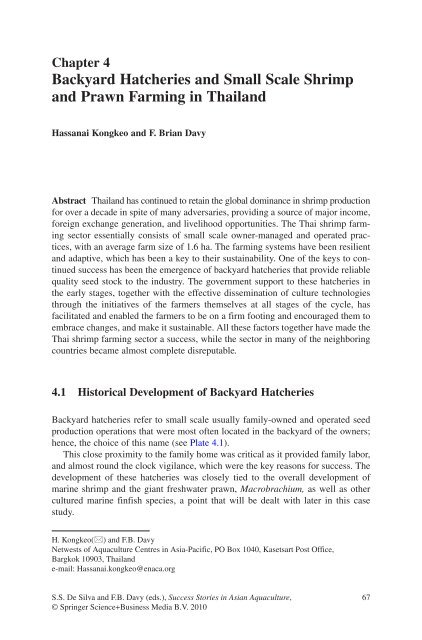Success Stories In Asian Aquaculture - Library - Network of ...
Success Stories In Asian Aquaculture - Library - Network of ...
Success Stories In Asian Aquaculture - Library - Network of ...
- No tags were found...
You also want an ePaper? Increase the reach of your titles
YUMPU automatically turns print PDFs into web optimized ePapers that Google loves.
Chapter 4Backyard Hatcheries and Small Scale Shrimpand Prawn Farming in ThailandHassanai Kongkeo and F. Brian DavyAbstract Thailand has continued to retain the global dominance in shrimp productionfor over a decade in spite <strong>of</strong> many adversaries, providing a source <strong>of</strong> major income,foreign exchange generation, and livelihood opportunities. The Thai shrimp farmingsector essentially consists <strong>of</strong> small scale owner-managed and operated practices,with an average farm size <strong>of</strong> 1.6 ha. The farming systems have been resilientand adaptive, which has been a key to their sustainability. One <strong>of</strong> the keys to continuedsuccess has been the emergence <strong>of</strong> backyard hatcheries that provide reliablequality seed stock to the industry. The government support to these hatcheries inthe early stages, together with the effective dissemination <strong>of</strong> culture technologiesthrough the initiatives <strong>of</strong> the farmers themselves at all stages <strong>of</strong> the cycle, hasfacilitated and enabled the farmers to be on a firm footing and encouraged them toembrace changes, and make it sustainable. All these factors together have made theThai shrimp farming sector a success, while the sector in many <strong>of</strong> the neighboringcountries became almost complete disreputable .4.1 Historical Development <strong>of</strong> Backyard HatcheriesBackyard hatcheries refer to small scale usually family-owned and operated seedproduction operations that were most <strong>of</strong>ten located in the backyard <strong>of</strong> the owners;hence, the choice <strong>of</strong> this name (see Plate 4.1 ).This close proximity to the family home was critical as it provided family labor,and almost round the clock vigilance, which were the key reasons for success. Thedevelopment <strong>of</strong> these hatcheries was closely tied to the overall development <strong>of</strong>marine shrimp and the giant freshwater prawn, Macrobrachium, as well as othercultured marine finfish species, a point that will be dealt with later in this casestudy.H. Kongkeo() and F.B. DavyNetwests <strong>of</strong> <strong>Aquaculture</strong> Centres in Asia-Pacific , PO Box 1040 , Kasetsart Post Office ,Bargkok 10903 , Thailande-mail: Hassanai.kongkeo@enaca.orgS.S. De Silva and F.B. Davy (eds.), <strong>Success</strong> <strong>Stories</strong> in <strong>Asian</strong> <strong>Aquaculture</strong>,© Springer Science+Business Media B.V. 201067
















